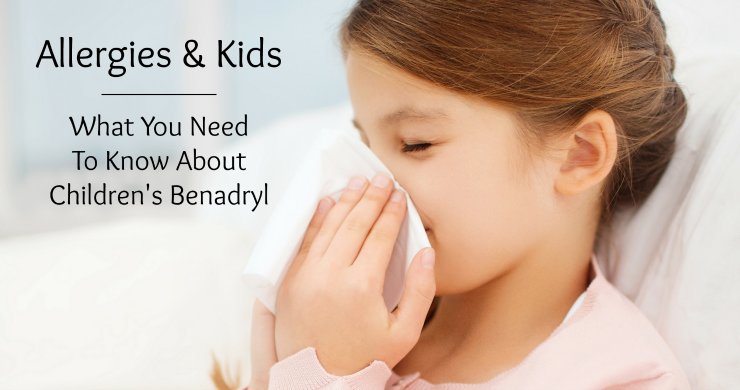Children’s Benadryl Dosage Chart
June 7, 2017
Benadryl (also known by it’s generic name: diphenhydramine) is a common allergy medication used in children. Benadryl is an antihistamine and it treats symptoms like runny nose, sneezing, itching, watery eyes, and hives. Over the years, parents have asked me many questions about the usage of Benadryl and the correct children’s Benadryl dosage.

Children’s Benadryl Dosage
Before reaching for that over-the-counter bottle, here are a few things I always want parents to keep in mind:
1. Benadryl should not be used under the age of 1 year old without guidance and instruction from your pediatric provider. Benadryl has a sedative effect for many people, and this can be dangerous in very small infants. While we do use Benadryl for some children having a serious allergic reactions or widespread hives, either of these conditions would warrant calling your pediatric provider immediately before using medications at home.
2. Benadryl is effective for allergies. It is not generally effective for other conditions. Too much histamine in the body produces annoying allergy symptoms (sneezing, runny nose, itching, watery eyes, etc). Benadryl works by blocking histamine in your child’s body. Many parents popularly try this medication for children that have colds. However, unless your child genuinely has too much histamine triggering his or her allergy symptoms, you will see little to no benefit. Because the symptoms of allergies can easily be confused with cold symptoms, consult your pediatric provider before giving Benadryl to a child with a cold.
3. Sedation is a well-known side effect of Benadryl. Many children get very drowsy and sleepy after taking a dose. For this reason, some parents have used use Benadryl to make their children sleepy during travel. Be warned though, occasionally children have a paradoxical reaction to Benadryl, which means it can make them hyper and alert. Giving children Benadryl to make them sleepy is generally not recommended. Consult with your pediatric provider before doing this.
4. The generic version of children’s Benadryl is called diphenhydramine. Benadryl and diphenhydramine are the exact same medications. For this reason, I always advise parents to get whatever option is the most affordable medication.
5. If your child has underlying medical problems, consult your pediatric provider before using Benadryl. Also, if your child has had adverse reactions to Benadryl or any antihistamine medicines in the past, consult your pediatric provider.
6. Keep Benadryl and all medication locked and out of reach of children. If you suspect your child has overdosed on a medication, call the American Association of Poison Control Centers immediately at (800) 222-1222.
Children’s Benadryl Dosage Chart
Click Here to Download your FREE chart!
Important Children’s Benadryl Dosage Information
- The correct Benadryl dosage for your child is always based on weight, and not age. Download the chart above for weight-based Benadryl dosing guidelines.
- Benadryl is available in liquid, capsules and tablets. Always make sure you look at the milligrams on the label to give the correct dose. These different forms of medication have different concentrations.
- Always use a syringe or dropper for measuring liquid medications. Kitchen spoons are not accurate for measuring over-the-counter medication.
- Do not give children Benadryl more than every 6-8 hours.
Most importantly, always contact your pediatric healthcare provider or pharmacist if you have questions about medicine you are giving your child.
Author: Dani Stringer, MSN, CPNP, PMHS – founder of KidNurse and MomNurse Academy